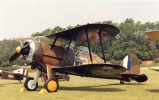
Gloster Gladiator1177 viewsThe Gloster Gladiator (or Gloster SS.37) was a British-built biplane fighter. It was used by the Royal Air Force (RAF) and the Royal Navy (as the Sea Gladiator variant) and was exported to a number of other air forces during the late 1930s. It was the RAF's last biplane fighter aircraft and was rendered obsolete by newer monoplane designs even as it was being introduced. Though often pitted against more formidable foes during the early days of the Second World War, it acquitted itself reasonably well in combat.
The Gladiator saw action in almost all theatres during the Second World War, with a large number of air forces, some of them on the Axis side. The RAF used it in France, Norway, Greece, the defence of Malta, and the brief Anglo-Iraqi War (in which the Royal Iraqi Air Force was similarly equipped). Other countries deploying the Gladiator included China against Japan, beginning in 1938; Finland (along with Swedish volunteers) in the Winter War and the Continuation War; and Norway, Belgium, and GreeceJan 12, 2011
|
|
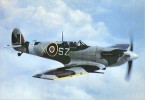
Supermarine Spitfire Mk Vb1078 viewsThe Mk V was produced in greater numbers than any other single mark of Spitfire. It was the main version of the fighter during 1941, replacing the Mk I and II in service in time to take part in the first British counterattacks over France. During the summer of 1941 it held an advantage over the Bf 109, but in September 1941 the Fw 190 made its operation debut, and the Mk V found itself outclassed. Despite this, it remained the main RAF fighter until the summer of 1942, and the low level LF.Mk V remained in use into 1944.Jan 10, 2011
|
|
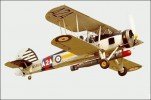
Fairey Albacore1145 viewsThe Fairey Albacore is a single-engine carrier-borne biplane torpedo bomber built by Fairey Aviation between 1939 and 1943 for the Fleet Air Arm. It had a three-man crew and was designed for spotting and reconnaissance as well as delivering bombs and torpedoes. The Albacore, popularly known as the "Applecore", was conceived as a replacement for the ageing Fairey Swordfish, which had entered service in 1936. However, the Albacore served with the Swordfish and was retired before it, being replaced by the monoplane Fairey Barracuda torpedo bomber.
The Albacore prototypes were built to meet Specification S.41/36 for a three-seat TSR (torpedo/spotter/reconnaissance) for the FAA. The first of two prototypes flew on December 12 1938 and production of the first batch of 98 aircraft began in 1939. Early Albacores were fitted with the Bristol Taurus II engine and those built later received the more powerful Taurus XII.
No. 826 Squadron FAA was specially formed to operate the first Albacores in March, 1940. Carrier-based squadrons began operating the Albacore in 1941. Eventually there were 15 FAA squadrons equipped with the plane which operated widely in the Mediterranean. Albacores participated in the Battle of Cape Matapan and the fighting at El Alamein as well as supporting the landings at Sicily and Salerno. During the period September 1941 to end of June 1943 No. 828 Squadron FAA, Hal-Far, Malta, operated a squadron of TSR Fairey Albacores under some of the most severe blitz conditions imaginable during the siege of Malta, mainly against Italian shipping and shore targets in Sicily.
In 1943 the Albacore was replaced by the Barracuda. The last Albacore squadron, No. 841, disbanded in late 1943. The Royal Canadian Air Force took over the Albacores and used them during the Normandy invasion.Sep 18, 2006
|
|
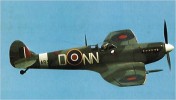
SUPERMARINE SPITFIRE Mk Vc570 viewsPossibly the most famous of all fighters, this particular aeroplane was re-activated to take part in the film "Battle of Britain" in which it flew nearly 50 hours. Now flying reularly at the Shuttleworth Collection.Dec 20, 2004
|
|
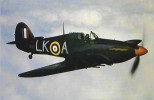
HAWKER HURRICANE Mk IIC604 viewsThis most famous partner to the Spitfire was the predominant fighter in use by the RAF during the Battle of Britain. Designed by Sidney Camm, this aircraft was the first RAF fighter to exceed 300mph & the first eight gun monoplane to enter service. This aircraft saw service throughout the war & was the mount of many great pilots of the War years. It is an interesting & judicious point to note that there were 1,326 Hurricanes & 967 Spitfires on strength during the Battle of Britain, a fine testimony to this fine aeroplane, This particular aircraft was flown by Sqn. Ldr. D. G. Smallwood.Dec 20, 2004
|
|
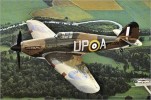
HAWKER HURRICANE Mk IIB502 viewsThe Hurricane bore the brunt of the fighting during the Battle of Britain &, of the 14,00 built, only three examples remain airworthy. This particular machine is painted to represent the aircraft of the late Squadron Leader Archie McKellarDec 20, 2004
|
|
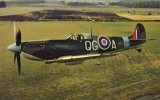
VICKERS ARMSTRONG SUPERMARINE SPITFIRE Mk 1A557 viewsSingle seat fighter powered by a Rolls Royce Merlin II or III liquid cooled in line engine. Maximum speed: 367mph. Armament: eight .303 machine guns. First deliveries to No. 19 Squadron Duxford, June 1938.Dec 19, 2004
|
|
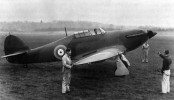
Hurricane MKI543 views The new Mk.I included a deHaviland or Rotol constant-speed metal propeller, ejector exhaust stacks for added thrust, metal-covered wings, armour and other changes. At the start of the war the RAF had taken on about 500 of this later design, and it formed the backbone of the fighter squadrons during the Battle of France and into the Battle of Britain.
Although it may have been an older design, the Hurricane was still a worthy fighter on its own and a reasonable match for the Messerschmitt Bf 109 it faced. In the photo The first production Hurricane Mk.I at [[Brooklands]], November 1937.Dec 19, 2004
|
|
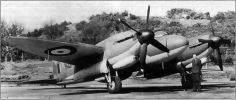
vickersf741437 viewsSep 24, 2004
|
|
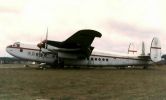
Avro 685 York574 viewsA transport development of the Lancaster, with a bigger fuselage of rectangular cross-section and an additional tailfin. Production during WWII was limited because it was agreed that the US would supply transport aircraft. Sep 24, 2004
|
|
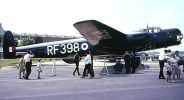
Avro Lincoln436 viewsHeavy bomber developed from the Lancaster, and initially known as the Lancaster B Mk.IV. The Lincoln, bigger and with a longer range, was developed for a British campaign in the far East, but was never used in this role because of the end of WWII. It compared unfavourably with more modern designs like the B-29, but was kept in service until 1963 and saw in combat over Kenya and Malaya. One was shot down on its way to Berlin in 1957. Sep 24, 2004
|
|

Avro Lancaster409 viewsThe Lancaster bomber was one of the most famous bombers of World War 2 its bomb load exceeding that of any other aircraft in full-scale production at the time. Only two examples are flying at the present time although there are several static examples in existence. With four Rolls-Royce Merlin engines giving a top speed of 287 mph and a range of 1,660 miles, the Lancaster’s’ seven-man crew could provide a knockout punch with a typical load of 18,000 pounds of high explosive over the target. Along with the Handley Page Halifax, the Lancaster gave the UK the offensive striking power needed to penetrate German air defenses during World War II. Sep 24, 2004
|
|
|
|